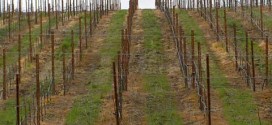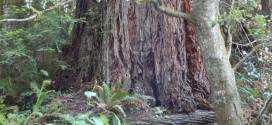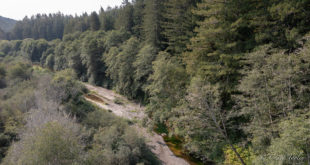Just when we thought we had seen everything as far as environmental threats to our river, two more contenders have surfaced. The wildest is an application with the California Division of Water Rights by an Alaskan based international company to get appropriative rights to pump thousands of acre feet of water yearly from the lower reaches of the Gualala and Albion Rivers and fill ocean going bladders for towing to Southern California. This promises to be an interesting fight with broad implications as to the future commodification of natural resources in the public trust.
Another major issue facing coastal forests is whether they will survive as the “Redwood Empire” or disappear and be replaced by the “Red Wine Empire”. Numerous applications have been filed with California Department of Forestry requesting permission to cut down hundreds of acres of forest and replace it with wine vineyards. Some projects in the planning stages are rumored to be as large as 4,000 to 10,000 acres. The entrepreneurs have targeted land that lies in a coastal climate zone that they say is ideal for pinot noir grapes.
The largest project proposed has been one submitted by a corporation based in Spain. With this recent wave of applications, functioning redwood and conifer forest is being targeted for permanent conversion to intensive, irrigated, commercial agriculture.
These conversions entail clear cutting, ripping the soil to a four feet depth, re-contouring, trapping of rain water in large reservoirs, ground water pumping, erecting miles of six foot high wildlife fencing and wire trellises, application of herbicides and pesticides, altering the watershed’s hydrological regime, changing ambient air and water temperatures due to deforestation, habitat fragmentation and loss of biodiversity, etc. And if economics sour for wine grapes as they have started to this year, other development could be proposed to replace the unprofitable vineyards.
In the Annapolis area of northwest Sonoma County, we have already lost much of our oak woodlands and open grassland to vineyards. Some of the open areas were once forested and were cleared for past agriculture. These grasslands, oak woodlands and formerly cultivated areas are now being converted without proper review, and regulation is in disarray. This conversion of oak forest has environmental impacts that are as serious as the conifer conversions.
The biggest omission in the review process is the lack of any true study of the cumulative environmental impacts. There is no inventory of data in place at any agency that addresses the potential cumulative impacts of the projects already proposed, the rate of conversion, or the amount of soil type and climate zone that is potentially subject to conversion pressures in the watersheds.
The initial studies do not list all the present applications or foreseeable future ones. Registered Professional Foresters (RPFs), hired by the submitters, invariably provide inadequate environmental review. One of these RPFs recently stated on the first page of his report that this forestland conversion should be considered a “crop rotation”. These initial studies contend that that there will be no significant environmental effects. They base this mainly on a comparison of the size of their project to the remaining stock of forestland in Sonoma County.
This deforestation of coastal redwood and conifer forestland poses a significant threat to biodiversity and water quantity and quality in our watersheds. Decreased water volume in the rivers and possible chemical releases will result. To the north, the Navarro River is now experiencing seriously low flows due to upstream diversion of water by new vineyards.
One question to be asked is what will the consequences be for those now using the Gualala River as their water source. The potential harm posed by these conversions warrant minimally the requirement of a programmatic Environmental Impact Report that addresses the possible cumulative impacts. Now is the time to require the most thorough environmental review.
Much time and energy are being expended by governmental agencies and watershed stakeholders to deal with the restoration of these watersheds and their endangered species. It is unconscionable to allow the loss of forestland to vineyards upslope of salmonid populations now struggling to survive – all for the sake of higher profits.
It is hoped that “Chainsaw Wine” will not be the farewell toast to the Redwood Empire.
Write to the California Department of Forestry, the Sonoma County Board of Supervisors, and the Sonoma County Planning Department asking for an Environmental Impact Report on this new threat to our coastal watersheds. Mention the following points. Forestland conversion warrants the preparation an E.I.R. due to:
- the lack of cumulative impact review of all of the proposed plans together
- the ground water scarcity of the coastal areas
- the 303(d) Clean Water Act listings of the north coast rivers
- the dire situation of the threatened indicator salmonid species
- the large, complex ecological changes and effects of conversions
- the clear written mandate of the County’s own General Plan
- the need to study the effects of commercial reservoirs and wells on local streams, rivers and aquifers
| A version of this commentary was published in the Independent Coast Observer on March 29, 2002. |
 Friends of Gualala River Protecting the Gualala River watershed and the species living within it
Friends of Gualala River Protecting the Gualala River watershed and the species living within it


